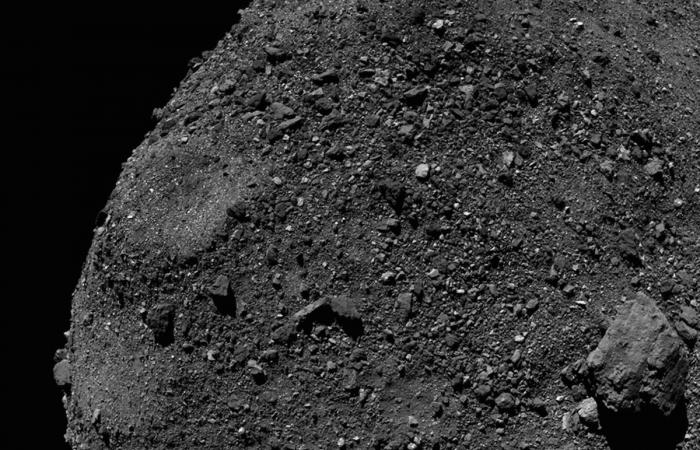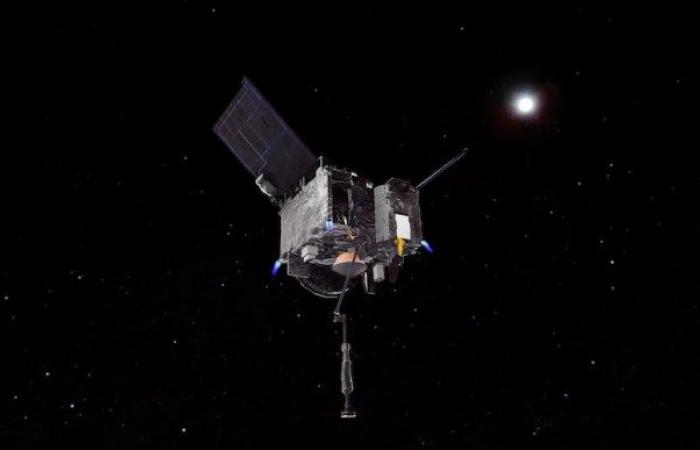Scientists say NASA’s contact and landing with NASA’s OSIRIS-REx spacecraft on an asteroid last month provided new insights into the structure of loose rocks that can cover the surfaces of many small planetary bodies – material more like a playground ball pit as solid bedrock.
The structure of the asteroid’s outermost layer is evident in images captured by the OSIRIS-REx spacecraft as it crashed into the airless world more than 330 million kilometers from Earth on October 20.
The next day, NASA released images from a narrow-angle camera aimed at the spacecraft’s 3.4 meter long robotic arm. A plate-sized sample collector at the end of the arm fired a bottle of compressed nitrogen gas as the spacecraft hit the surface of the asteroid Bennu, a small planetary body about a third of a mile in diameter.
The release of nitrogen gas helped force asteroid samples into the collection chamber. After six seconds on the surface of the asteroid, OSIRIS-REx fired engines to pull away from Bennu.
Scientists later obtained close-ups of the sample collection head, showing that it was filled with material scooped up from the asteroid’s surface. Some asteroid particles were visible emerging from the collection chamber, prompting managers to order the spaceship to put the probe head in its earth return capsule earlier than expected to minimize sample loss.
The sampler was sealed in the return capsule of the OSIRIS-REx spacecraft on October 28th.
Late last week, officials released another series of images captured while the spacecraft was touching and landing. These were recorded with a wide-angle navigation camera on OSIRIS-REx.
According to the OSIRIS-REx science team, the images from the navigation camera – or NavCam – were taken over a period of approximately three hours. The sequence begins approximately one hour after OSIRIS-REx performs an orbit maneuver to begin the descent and ends approximately two minutes after the spacecraft burns back.
A turning or rotation maneuver is visible in the middle of the image sequence when OSIRIS-REx points its sampling arm at the target sampling point of the asteroid Bennu, a region called the “nightingale”.
“As the spaceship approaches the Nightingale location, the shadow of the sampling arm becomes visible in the lower part of the frame. Shortly thereafter, the sampling head hits the Nightingale spot (just outside the camera’s field of view, top right) and fires a nitrogen bottle, which mobilizes a significant amount of the material from the sample spot, ”wrote the OSIRIS-REx team in a description of the NavCam images .
“A few seconds later, the spacecraft burns back and the shadow of the sampling arm is visible on the disturbed surface material. The team continues to investigate what caused the extremely dark areas in the top and middle parts of the frame, ”the team wrote. “The top area could be the edge of the indentation created by the sampling arm, a heavy shadow cast by material spilled from the surface, or a combination of both.
“Similarly, the middle dark area that first appears in the lower left corner of the image could be a depression caused by one of the spacecraft’s engines when fired, a shadow caused by material being pulled up, or a combination of both. ”
The OSIRIS-REx spaceship, built by Lockheed Martin, relied on the black and white navigation camera images to autonomously guide itself to a safe touchdown zone on Bennu. Navigation algorithms compared the camera’s images with a map pre-installed in the spacecraft’s computer and helped OSIRIS-REx to determine its position relative to the asteroid.
With its sample in the return capsule, OSIRIS-REx will leave the vicinity of the asteroid Bennu next year to begin the journey back to Earth. The spacecraft will release the return capsule for re-entry into the Earth’s atmosphere and landing at the Utah Test and Training Range on September 24, 2023.


NASA’s $ 1 billion Origins, Spectral Interpretation, Resource Identification, Security and Regolith Explorer mission was launched on September 8, 2016 from Cape Canaveral on board a United Atlas 5 rocket Launch Alliance started. The main goal of OSIRIS-REx is to bring asteroid samples back to Earth for detailed analysis by scientists hoping to find clues to the origins of the solar system.
The mission requirement was that OSIRIS-REx collected at least 60 grams of asteroid material. Scientists said before Oct. 20 the spacecraft could collect much more, and there is evidence that it likely captured more than 1 kg of asteroid samples, according to Dante Lauretta, the mission’s lead researcher at the University of Arizona.
Data from the brief landing on the asteroid showed that the spacecraft’s robotic arm sank up to 48 centimeters into the soft surface of the Bennu.
While the mission’s scientific payoff will wait for the asteroid samples to return to Earth, Lauretta said Thursday that scientists are already learning about Bennu’s physical properties.
The spacecraft discovered small particles that flew in front of Bennu shortly after arriving at the asteroid in December 2018. These particles resemble the flaky material that leaked from the TAGSAM head.
“It looks like a box of cereal in space,” said Lauretta. “And they flutter around in random motion. They mostly come from the TAGSAM head, but they collide with each other. They spin and fall. We can solve many of them.
“So it’s a great data set to use for image calibration to better understand the particle ejection events and particle trajectories that we observed throughout the encounter with the asteroid,” said Lauretta. “Although my heart is breaking from the sample loss, it turns out to be a pretty cool science experiment.”
OSIRIS-REx’s contact with the asteroid surface on October 20 also provided an extensive data set, suggesting that the outer layer of the asteroid floor and the low-density rocks were not very cohesive. The spacecraft’s robotic arm touched the asteroid as OSIRIS-REx approached at just 0.2 miles per hour, or 10 centimeters per second, which is about a tenth the speed of a typical walking pace.
“When the TAGSAM head made contact with the regolith, it just flowed away like a liquid,” said Lauretta. “And I think that’s what would happen to an astronaut if she tried to walk on the surface of the asteroid. You would sink to your knees or lower – depending on how loose the ground was – until you hit a larger boulder or some sort of bedrock. ”
He said the “basic truth” data collected by OSIRIS-REx would help scientists re-examine models of asteroid geology.
“It’s fascinating that the asteroid surface offered so little resistance to the spaceship,” said Lauretta. “Basically, it’s like a ball pit in a children’s playground. You kind of jump in and just sink into it.
“Luckily we had these reverse engines to reverse the direction of motion, or we just went all the way through the asteroid,” joked Lauretta.
The new asteroid density measurements from OSIRIS-REx will help scientists refine the impact risk assessment that Bennu could pose to Earth. Scientists have calculated a 1 in 2,700 probability that Bennu could hit Earth by the end of the 21st century.
Much of the asteroid could burn up in the earth’s atmosphere due to its porosity.
“Thermal analysis shows that much of the material on Bennu’s surface – especially the large black, hilly boulders that are a major part of the surface – has material properties that would not survive intact passage through the atmosphere,” said Lauretta. “You would fragment and much of the material will be lost.”
That is, the pristine specimens collected by Bennu are different from any meteorites or asteroid fragments that fell to Earth and reached the surface intact.
Email to author.
Follow Stephen Clark on Twitter: @ StephenClark1.
These were the details of the news Scientists publish new view of OSIRIS-REx ‘Asteroid Smash and Grab –... for this day. We hope that we have succeeded by giving you the full details and information. To follow all our news, you can subscribe to the alerts system or to one of our different systems to provide you with all that is new.
It is also worth noting that the original news has been published and is available at de24.news and the editorial team at AlKhaleej Today has confirmed it and it has been modified, and it may have been completely transferred or quoted from it and you can read and follow this news from its main source.


